High-Sensitivity Refractive Index Sensor with Dual-Channel Based on Surface Plasmon Resonance Photonic Crystal Fiber
Abstract
:1. Introduction
2. Structure Design and Theoretical Modeling
3. Simulation Results and Discussion
3.1. Mode Analysis of Photonic Crystal Fiber
3.2. Effect of Structural Parameters on Sensing Performance
3.3. Performance Analysis
4. Conclusions
Author Contributions
Funding
Institutional Review Board Statement
Informed Consent Statement
Data Availability Statement
Conflicts of Interest
References
- Guo, Z.; Fan, Z.; Kong, X.; Meng, Z. Photonic crystal fiber based wide-range of refractive index sensor with phase matching between core mode and metal defect mode. Opt. Commun. 2020, 461, 125233. [Google Scholar] [CrossRef]
- Arismar Cerqueira, S., Jr. Recent progress and novel applications of photonic crystal fibers. Rep. Prog. Phys. 2010, 73, 024401. [Google Scholar] [CrossRef]
- Mohammed, N.A.; Khedr, O.E.; El-Rabaie, E.S.M.; Khalaf, A.A. Literature Review: On-Chip Photonic Crystals and Photonic Crystal Fiber for Biosensing and Some Novel Trends. IEEE Access 2022, 10, 3170912. [Google Scholar] [CrossRef]
- Hui, Z.; Zhang, Y.; Abdel-Hamid, S. Mid-infrared dual-rhombic air hole Ge20Sb15Se65 chalcogenide photonic crystal fiber with high birefringence and high nonlinearity. Ceram. Int. 2018, 44, 10383–10392. [Google Scholar] [CrossRef]
- Hui, Z.Q.; Zhang, J.G. Design of optical time-division multiplexed systems using the cascaded four-wave mixing in a highly nonlinear photonic crystal fiber for simultaneous time demultiplexing and wavelength multicasting. J. Optics 2015, 17, 075702. [Google Scholar] [CrossRef]
- Yang, H.; Zhao, J.; Xu, Q.; Yang, H.; Wang, H. Soliton colliding in hybrid glass photonic crystal fiber for optical transistor switching. Nonlinear Dyn. 2024, 112, 10291–10301. [Google Scholar] [CrossRef]
- Chiavaioli, F.; Gouveia, C.A.J.; Jorge, P.A.S.; Baldini, F. Towards a Uniform Metrological Assessment of Grating-Based Optical Fiber Sensors: From Refractometers to Biosensors. Biosensors 2017, 7, 23. [Google Scholar] [CrossRef]
- Dash, J.N.; Jha, R. SPR biosensor based on polymer PCF coated with conducting metal oxide. IEEE Photonic. Technol. Lett. 2014, 26, 595–598. [Google Scholar] [CrossRef]
- Rifat, A.A.; Mahdiraji, G.A.; Sua, Y.M.; Shee, Y.G.; Ahmed, R.; Chow, D.M.; Mahamd Adikan, F.R. Surface Plasmon Resonance Photonic Crystal Fiber Biosensor: A Practical Sensing Approach. IEEE Photonic. Technol. Lett. 2015, 27, 1628–1631. [Google Scholar] [CrossRef]
- Xue, J.; Zhang, Y.; Liu, W.; Zhang, Y.; Li, S.; Liu, Z.; Zhang, J.; Lai, B.; Yuan, L. Ultrahigh-sensitivity SPR fiber temperature sensor based Ge2Sb2Te5 and cyclohexane. Sensor. Actuat. A-Phys. 2022, 345, 113786. [Google Scholar] [CrossRef]
- Jain, S.; Choudhary, K.; Kumar, S. Novel Materials-Based Photonic Crystal Fiber Sensor for Biomedical Applications. Plasmonics 2024, 19, 1619–1632. [Google Scholar] [CrossRef]
- Wang, H.; Zhang, W.; Chen, C.; Tang, S.; Liu, H. A new methane sensor based on compound film-coated photonic crystal fiber and Sagnac interferometer with higher sensitivity. Results Phys. 2019, 15, 102817. [Google Scholar] [CrossRef]
- Abbaszadeh, A.; Rash-Ahmadi, S. A novel graphene-based circular dual-core photonic crystal fiber pressure sensor with high sensitivity. Appl. Phys. A-Mater. 2023, 129, 570. [Google Scholar] [CrossRef]
- Danlard, I.; Mensah, I.O.; Akowuah, E.K. Design and numerical analysis of a fractal cladding PCF-based plasmonic sensor for refractive index, temperature, and magnetic field. Optik 2022, 258, 168893. [Google Scholar] [CrossRef]
- Anik, M.H.K.; Islam, S.M.R.; Talukder, H.; Mahmud, S.; Isti, M.I.A.; Sadeghi-niaraki, A.; Kwak, K.-S.; Biswas, S.K. A highly sensitive quadruple D-shaped open channel photonic crystal fiber plasmonic sensor: A comparative study on materials effect. Results Phys. 2021, 23, 104050. [Google Scholar] [CrossRef]
- Dubey, S.K.; Kumar, A.; Kumar, A.; Pathak, A.; Srivastava, S.K. A study of highly sensitive D-shaped optical fiber surface plasmon resonance based refractive index sensor using grating structures of Ag-TiO2 and Ag-SnO2. Optik 2022, 252, 168527. [Google Scholar] [CrossRef]
- Liu, W.; Liu, Z.; Zhang, Y.; Li, S.; Zhang, Y.; Yang, X.; Zhang, J.; Yuan, L. Specialty optical fibers and 2D materials for sensitivity enhancement of fiber optic SPR sensors: A review. Opt. Laser Technol. 2022, 152, 108167. [Google Scholar] [CrossRef]
- Santos, D.F.; Guerreiro, A.; Baptista, J.M. SPR optimization using metamaterials in a D-type PCF refractive index sensor. Opt. Fiber Technol. 2017, 33, 83–88. [Google Scholar] [CrossRef]
- Liu, Y.; Jing, X.; Li, S.; Zhang, S.; Zhang, Z.; Guo, Y.; Wang, J.; Wang, S. High sensitivity surface plasmon resonance sensor based on D-shaped photonic crystal fiber with circular layout. Opt. Fiber Technol. 2018, 46, 311–317. [Google Scholar] [CrossRef]
- Wang, S.; Li, S. Surface plasmon resonance sensor based on symmetrical side-polished dual-core photonic crystal fiber. Opt. Fiber Technol. 2019, 51, 96–100. [Google Scholar] [CrossRef]
- Saleh Falah, A.A.; Wong, W.R.; Adikan, F.R.M. Single-mode eccentric-core D-shaped photonic crystal fiber surface plasmon resonance sensor. Opt. Laser Technol. 2022, 145, 107474. [Google Scholar] [CrossRef]
- Bing, P.; Wu, G.; Sui, J.; Zhang, H.; Tan, L.; Li, Z.; Yao, J. Double Samples Synchronous Detection Sensor based on Up-Core Photonic Crystal Fiber. Optik 2020, 224, 165522. [Google Scholar] [CrossRef]
- Fang, H.; Wei, C.; Jiang, W.; Wang, D.; Li, J. Highly efficient symmetrical dual-channel D-type photonic crystal fiber surface plasmon resonance sensor. J. Opt. Soc. Am. B 2022, 39, 1–8. [Google Scholar] [CrossRef]
- Mumtaz, F.; Zhang, B.; Roman, M.; Abbas, L.G.; Ashraf, M.A.; Dai, Y. Computational study: Windmill-shaped multi-channel SPR sensor for simultaneous detection of multi-analyte. Measurement 2023, 207, 112386. [Google Scholar] [CrossRef]
- Azman, M.F.; Mashrafi, M.; Haider, F.; Ahmed, R.; Ahmmed, R.A.; Junayed, M.; Ru, W.W.; Mahdiraji, G.A.; Adikan, F.R.M. Polarization Selective PCF-Based Plasmonic Biosensor for Multi-Analyte Detection. Plasmonics 2024, in press. [Google Scholar] [CrossRef]
- Chow, D.M.; Sandoghchi, S.R.; Adikan, F.R.M. Fabrication of Photonic Crystal Fibers. In Proceedings of the 3rd International Conference on Photonics, Penang, Malaysia, 1–3 October 2012. [Google Scholar] [CrossRef]
- El Hamzaoui, H.; Ouerdane, Y.; Bigot, L.; Bouwmans, G.; Capoen, B.; Boukenter, A.; Girard, S.; Bouazaoui, M. Sol-gel derived ionic copper-doped microstructured optical fiber: A potential selective ultraviolet radiation dosimeter. Opt. Express 2012, 20, 29751–29760. [Google Scholar] [CrossRef] [PubMed]
- Knight, J.C.; Birks, T.A.; Russell, P.S.; Atkin, D.M. All-silica single-mode optical fiber with photonic crystal cladding. Opt. Lett. 1996, 21, 1547–1549. [Google Scholar] [CrossRef] [PubMed]
- Kumar, V.R.K.; George, A.K.; Reeves, W.H.; Knight, J.C.; Russell, P.S.J.; Omenetto, F.G.; Taylor, A.J. Extruded soft glass photonic crystal fiber for ultrabroad supercontinuum generation. Opt. Express 2002, 10, 1520–1525. [Google Scholar] [CrossRef] [PubMed]
- Zhang, X.; Wang, R.; Cox, F.M.; Kuhlmey, B.T.; Large, M.C.J. Selective coating of holes in microstructured optical fiber and its application to in-fiber absorptive polarizers. Opt. Express 2007, 15, 16270–16278. [Google Scholar] [CrossRef]
- Csaki, A.; Jahn, F.; Latka, I.; Henkel, T.; Malsch, D.; Schneider, T.; Schröder, K.; Schuster, K.; Schwuchow, A.; Spittel, R.; et al. Nanoparticle layer deposition for plasmonic tuning of microstructured optical fibers. Small 2010, 6, 2584–2589. [Google Scholar] [CrossRef]
- Sazio, P.J.A.; Amezcua-Correa, A.; Finlayson, C.E.; Hayes, J.R.; Scheidemantel, T.J.; Baril, N.F.; Jackson, B.R.; Won, D.J.; Zhang, F.; Margine, E.R.; et al. Microstructured optical fibers as high-pressure microfluidic reactors. Science 2006, 311, 1583–1586. [Google Scholar] [CrossRef] [PubMed]
- Boehm, J.; François, A.; Ebendorff-Heidepriem, H.; Monro, T.M. Chemical Deposition of Silver for the Fabrication of Surface Plasmon Microstructured Optical Fibre Sensors. Plasmonics 2011, 6, 133–136. [Google Scholar] [CrossRef]
- Politano, G.G.; Cazzanelli, E.; Versace, C.; Vena, C.; De Santo, M.P.; Castriota, M.; Ciuchi, F.; Bartolino, R. Graphene oxide on magnetron sputtered silver thin films for SERS and metamaterial applications. Appl. Surf. Sci. 2018, 427, 927–933. [Google Scholar] [CrossRef]
- Malitson, H. Interspecimen comparison of the refractive index of fused silica. J. Opt. Soc. Am 1965, 55, 1205–1209. [Google Scholar] [CrossRef]
- Shakya, A.K.; Singh, S. Design of dual polarized tetra core PCF based plasmonic RI sensor for visible-IR spectrum. Opt. Commun. 2021, 478, 126372. [Google Scholar] [CrossRef]
- Vial, A.; Grimault, A.-S.; Macías, D.; Barchiesi, D.; de la Chapelle, M.L. Improved analytical fit of gold dispersion: Application to the modeling of extinction spectra with a finite-difference time-domain method. Phys. Rev. B 2005, 71, 085416. [Google Scholar] [CrossRef]
- Rajeswari, D.; Revathi, A.A. Highly sensitive SPR-based PCF bio sensor for plasma cell detection in human blood for the detection of early stage cancer. Optik 2022, 258, 168897. [Google Scholar] [CrossRef]
- Sun, C.; Wang, W.; Jia, H. A squeezed photonic crystal fiber for residual dispersion compensation with high birefringence over S+C+L+U wavelength bands. Opt. Commun. 2020, 458, 124757. [Google Scholar] [CrossRef]
- Liu, C.; Fu, H.; Lv, Y.; Yi, Z.; Lin, J.; Lv, J.; Yang, L.; Chu, P.K. HE1,1 mode-excited surface plasmon resonance for refractive index sensing by photonic crystal fibers with high sensitivity and long detection distance. Optik 2022, 265, 169471. [Google Scholar] [CrossRef]
- Jiao, S.; Ren, X.; Yang, H.; Xu, S.; Li, X. Dual-Channel and Dual-Core Plasmonic Sensor-Based Photonic Crystal Fiber for Refractive Index Sensing. Plasmonics 2022, 17, 295–304. [Google Scholar] [CrossRef]
- Yasli, A.; Ademgil, H.; Haxha, S.; Aggoun, A. Multi-Channel Photonic Crystal Fiber Based Surface Plasmon Resonance Sensor for Multi-Analyte Sensing. IEEE Photonics J. 2020, 12, 1. [Google Scholar] [CrossRef]
- Divya, J.; Selvendran, S.; Raja, A.S.; Borra, V. A Novel Plasmonic Sensor Based on Dual-Channel D-Shaped Photonic Crystal Fiber for Enhanced Sensitivity in Simultaneous Detection of Different Analytes. IEEE Trans. NanoBiosci. 2024, 23, 1. [Google Scholar] [CrossRef] [PubMed]
- Haider, F.; Mashrafi, M.; Aoni, R.A.; Haider, R.; Hossen, M.; Ahmed, T.; Mahdiraji, G.A.; Ahmed, R. Multi-Analyte Detection Based on Integrated Internal and External Sensing Approach. IEEE Trans. NanoBiosci. 2022, 21, 29–36. [Google Scholar] [CrossRef] [PubMed]
- Gomez-Cardona, N.; Reyes-Vera, E.; Torres, P. High Sensitivity Refractive Index Sensor Based on the Excitation of Long-Range Surface Plasmon Polaritons in H-Shaped Optical Fiber. Sensors 2020, 20, 2111. [Google Scholar] [CrossRef] [PubMed]
- Lu, M.; Peng, W.; Liu, Q.; Liu, Y.; Li, L.; Liang, Y.; Masson, J.F. Dual channel multilayer-coated surface plasmon resonance sensor for dual refractive index range measurements. Opt. Express 2017, 25, 8563–8570. [Google Scholar] [CrossRef] [PubMed]
- DiPippo, W.; Lee, B.J.; Park, K. Design analysis of doped-silicon surface plasmon resonance immunosensors in mid-infrared range. Opt. Express 2010, 18, 19396–19406. [Google Scholar] [CrossRef]
- Patskovsky, S.; Kabashin, A.V.; Meunier, M. Properties and sensing characteristics of surface-plasmon resonance in infrared light. J. Opt. Soc. Am. A 2003, 20, 1644–1650. [Google Scholar] [CrossRef] [PubMed]
- Golosovsky, M.; Lirtsman, V.; Yashunsky, V.; Davidov, D.; Aroeti, B. Midinfrared surface-plasmon resonance: A novel biophysical tool for studying living cells. J. Appl. Phys. 2009, 105, 102036. [Google Scholar] [CrossRef]
- Rodrigo, D.; Limaj, O.; Janner, D.; Etezadi, D.; García de Abajo, F.J.; Pruneri, V.; Altug, H. Mid-infrared plasmonic biosensing with graphene. Science 2015, 349, 165–168. [Google Scholar] [CrossRef]
- Sachet, E.; Losego, M.D.; Guske, J.; Franzen, S.; Maria, J.P. Mid-infrared surface plasmon resonance in zinc oxide semiconductor thin films. Appl. Phys. Lett. 2013, 102, 051111. [Google Scholar] [CrossRef]
- Homola, J. Present and future of surface plasmon resonance biosensors. Anal. Bioanal. Chem. 2003, 377, 528–539. [Google Scholar] [CrossRef] [PubMed]





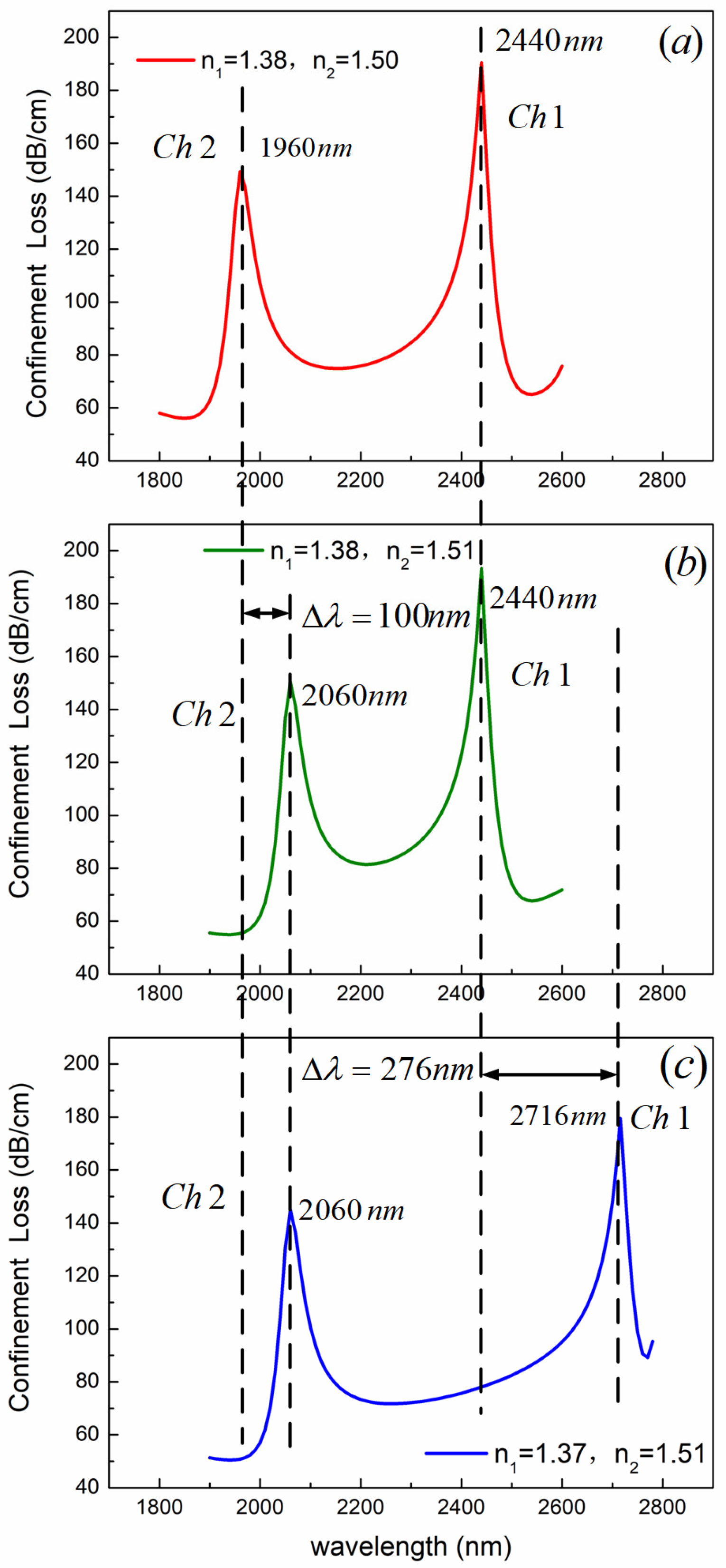
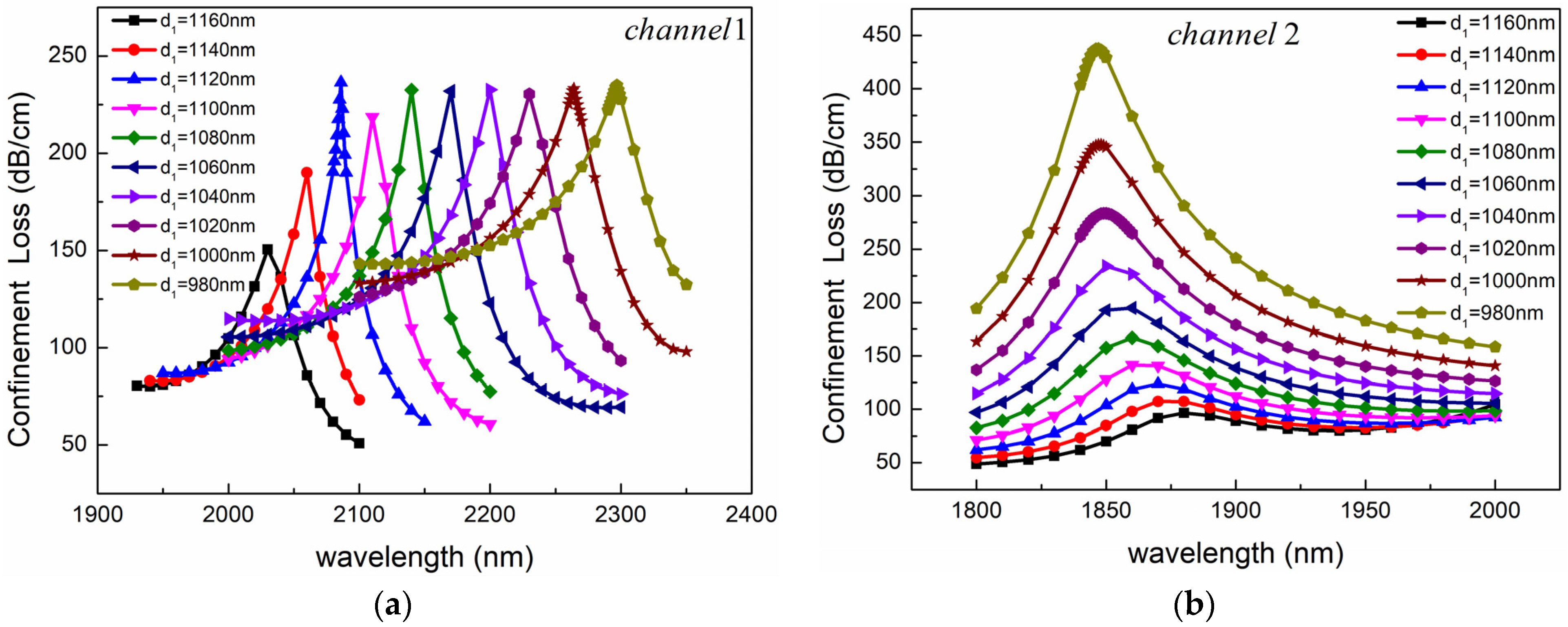
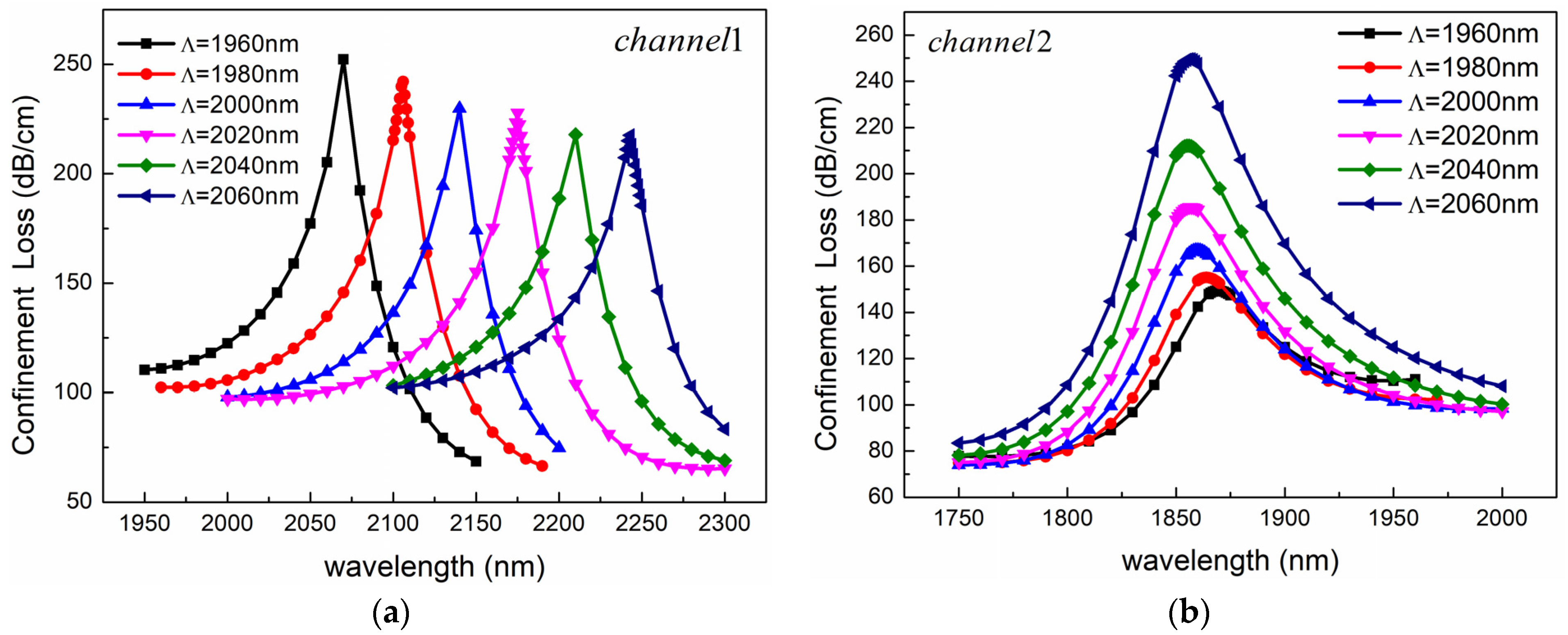

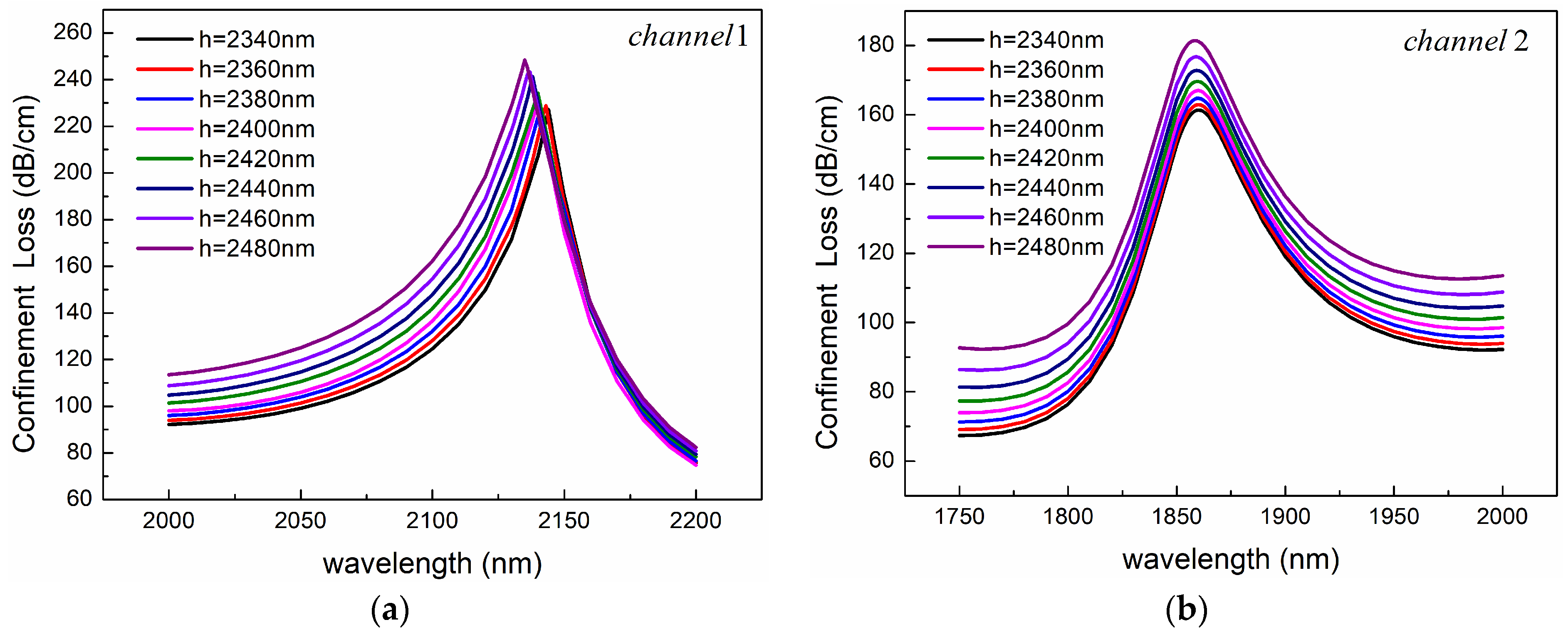


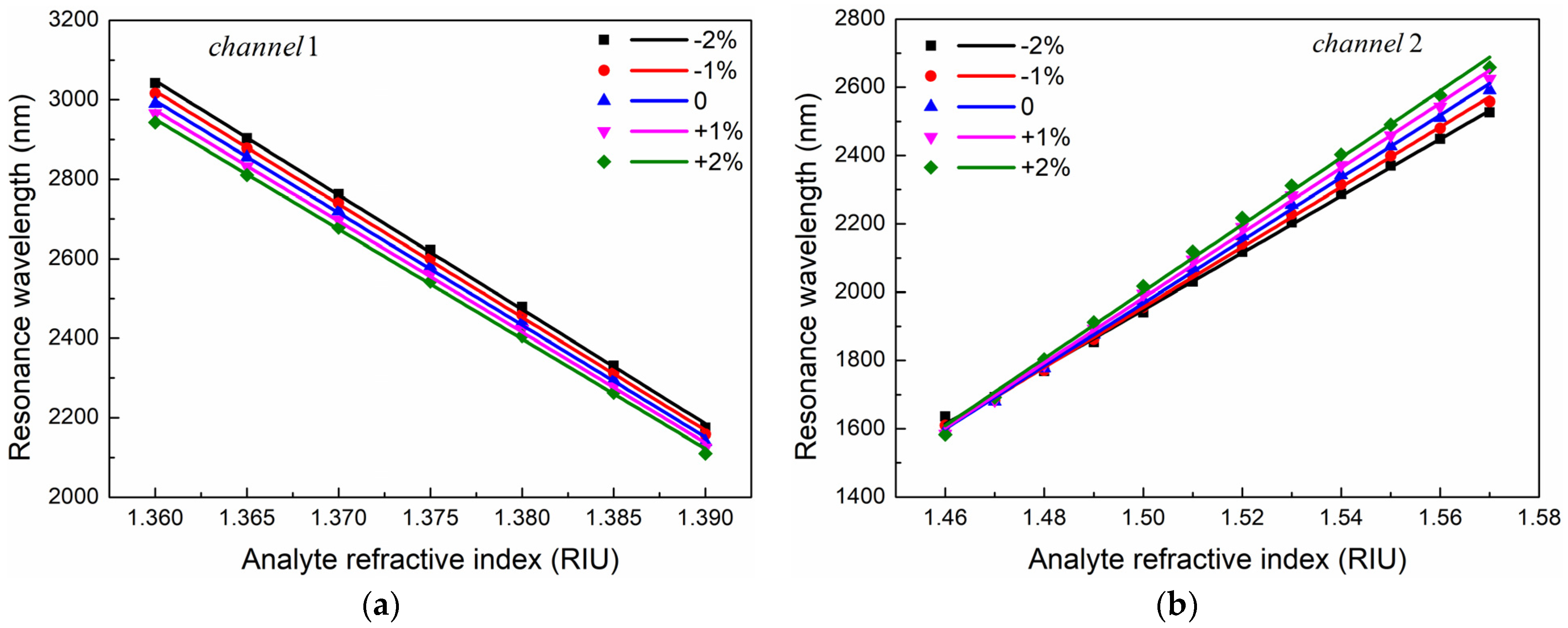
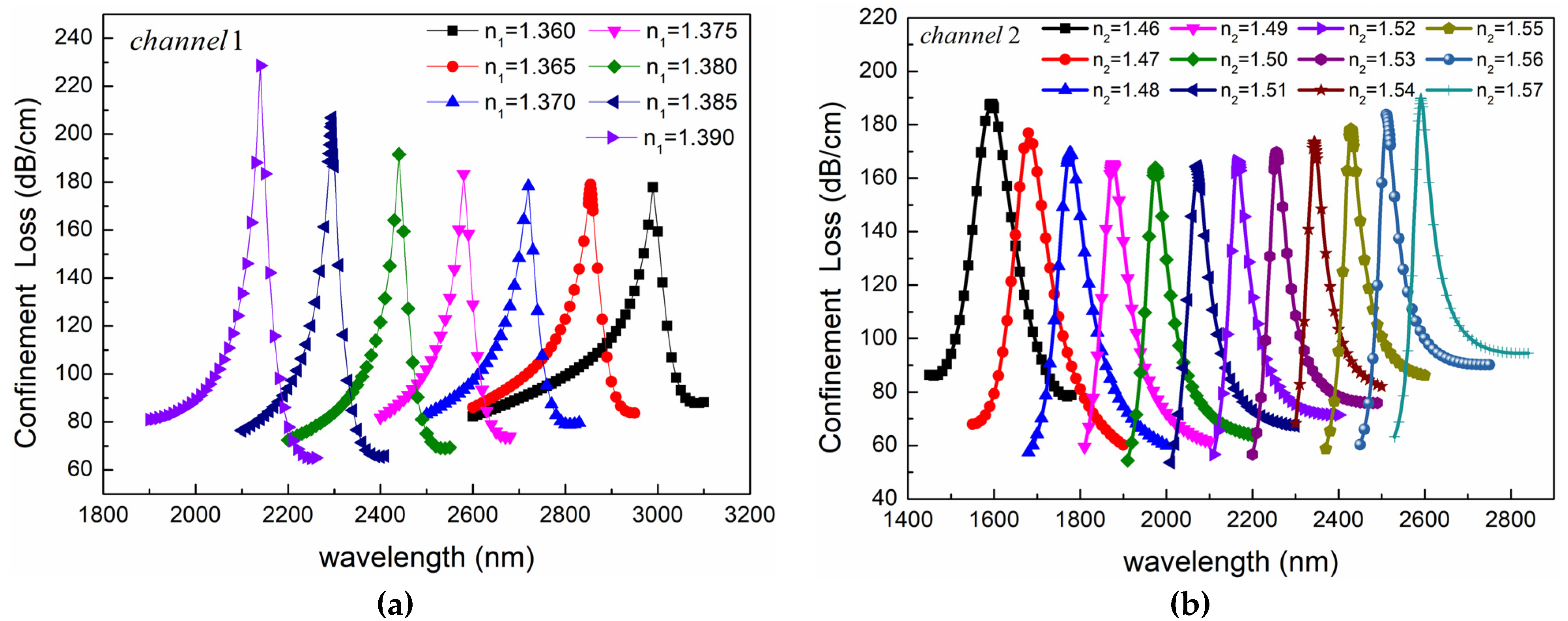


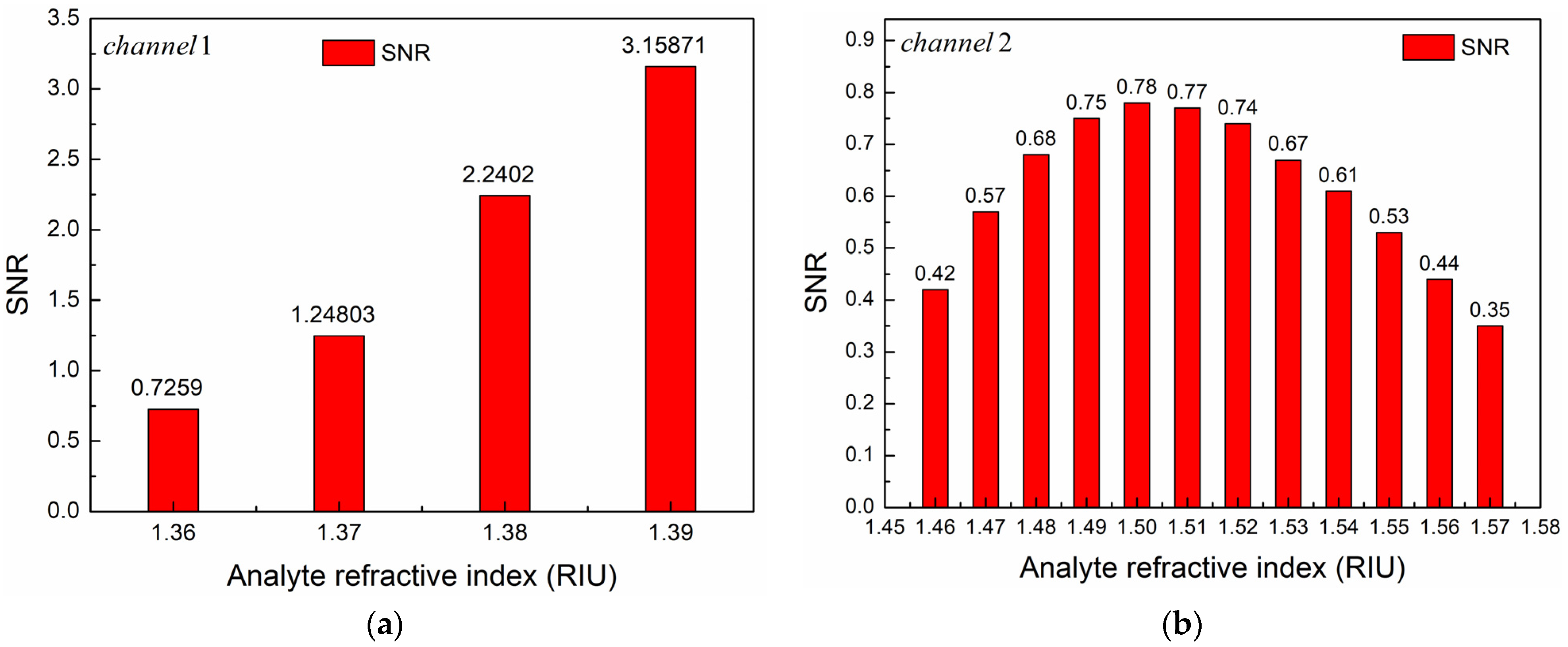
| References | Channel | RI Range (RIU) | Wavelength Range (nm) | (nm/RIU) | RI Resolution (RIU) | FOM (RIU−1) | Research Types |
|---|---|---|---|---|---|---|---|
| [41] | Ch 1 | 1.34–1.36 | 528–614 | 4280 | 2.34 × 10−5 | N/A | Numerical |
| Ch 2 | 1.34–1.36 | 658–738 | 3940 | 2.54 × 10−5 | N/A | ||
| [42] | Ch 1 | 1.33–1.366 | 400–800 | 1892 | 4 × 10−5 | N/A | Numerical |
| Ch 2 | 1.33–1.366 | 400–800 | 2337 | 3.2 × 10−5 | N/A | ||
| [43] | Ch 1 | 1.31–1.41 | 1350–1600 | 6000 | 5 × 10−5 | 125 | Numerical |
| Ch 2 | 1.31–1.41 | 1450–1650 | 6000 | 5 × 10−5 | 68.96 | ||
| [44] | Ch 1 | 1.33–1.40 | 530–970 | 12,000 | 8.33 × 10−6 | 200 | Numerical |
| Ch 2 | 1.33–1.39 | 530–970 | 10,000 | 1.0 × 10−5 | 145 | ||
| [45] | Ch 1 | 1.33–1.39 | 600–1500 | 7540 | 1.3 × 10−5 | 522 | Numerical |
| Ch 2 | 1.33–1.39 | 600–1500 | 7540 | 1.3 × 10−5 | 280 | ||
| [46] | Ch 1 | 1.3253–1.3726 | 700–850 | 2496 | N/A | N/A | Experimental |
| Ch 2 | 1.5255–1.5781 | 560–700 | 1951 | ||||
| This work | Ch 1 | 1.36–1.39 | 2100–3000 | 28,214.286 | 3.54 × 10−6 | 315.87 | Numerical |
| Ch 2 | 1.46–1.57 | 1500–2600 | 9190.9 | 10.88 × 10−6 | 77.87 |
Disclaimer/Publisher’s Note: The statements, opinions and data contained in all publications are solely those of the individual author(s) and contributor(s) and not of MDPI and/or the editor(s). MDPI and/or the editor(s) disclaim responsibility for any injury to people or property resulting from any ideas, methods, instructions or products referred to in the content. |
© 2024 by the authors. Licensee MDPI, Basel, Switzerland. This article is an open access article distributed under the terms and conditions of the Creative Commons Attribution (CC BY) license (https://creativecommons.org/licenses/by/4.0/).
Share and Cite
Wang, F.; Wei, Y.; Han, Y. High-Sensitivity Refractive Index Sensor with Dual-Channel Based on Surface Plasmon Resonance Photonic Crystal Fiber. Sensors 2024, 24, 5050. https://doi.org/10.3390/s24155050
Wang F, Wei Y, Han Y. High-Sensitivity Refractive Index Sensor with Dual-Channel Based on Surface Plasmon Resonance Photonic Crystal Fiber. Sensors. 2024; 24(15):5050. https://doi.org/10.3390/s24155050
Chicago/Turabian StyleWang, Fengmin, Yong Wei, and Yanhong Han. 2024. "High-Sensitivity Refractive Index Sensor with Dual-Channel Based on Surface Plasmon Resonance Photonic Crystal Fiber" Sensors 24, no. 15: 5050. https://doi.org/10.3390/s24155050





